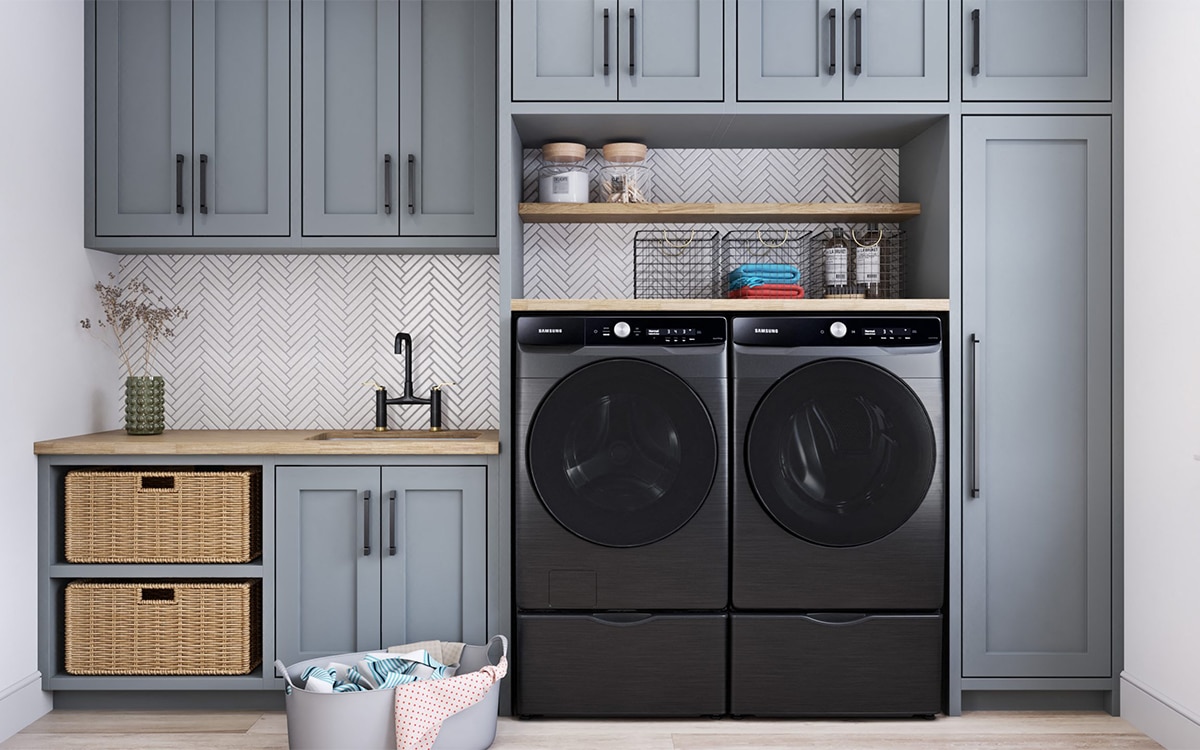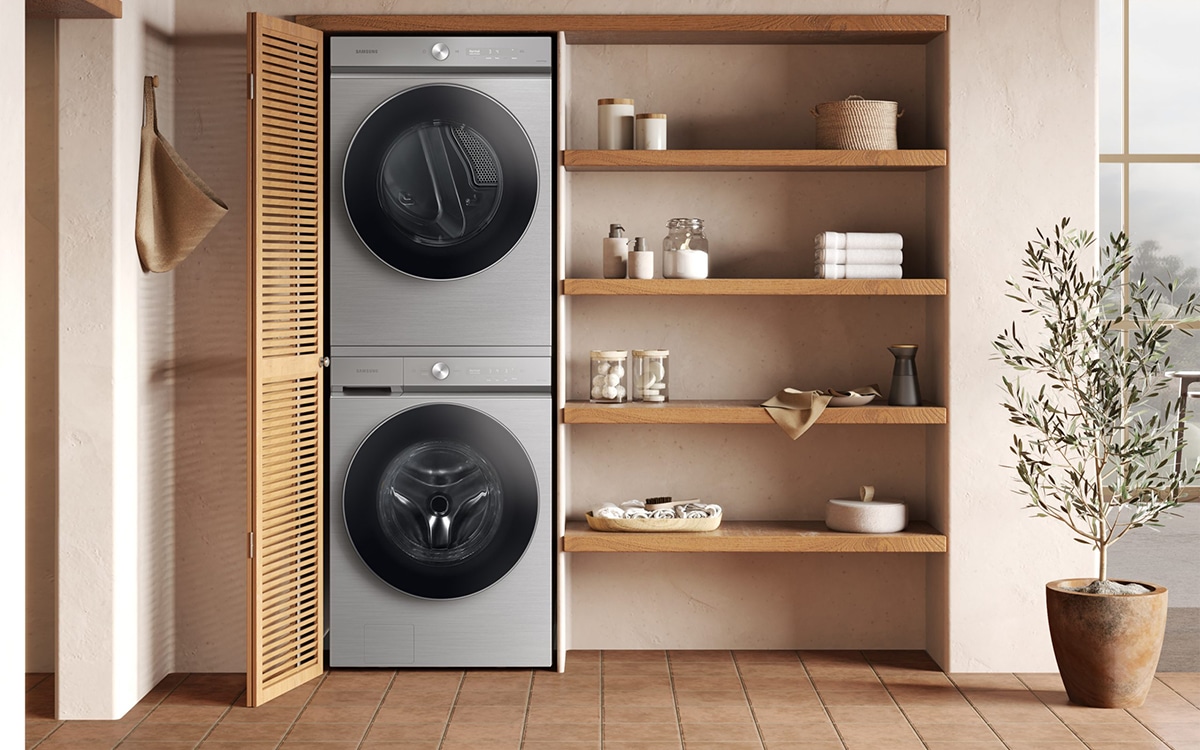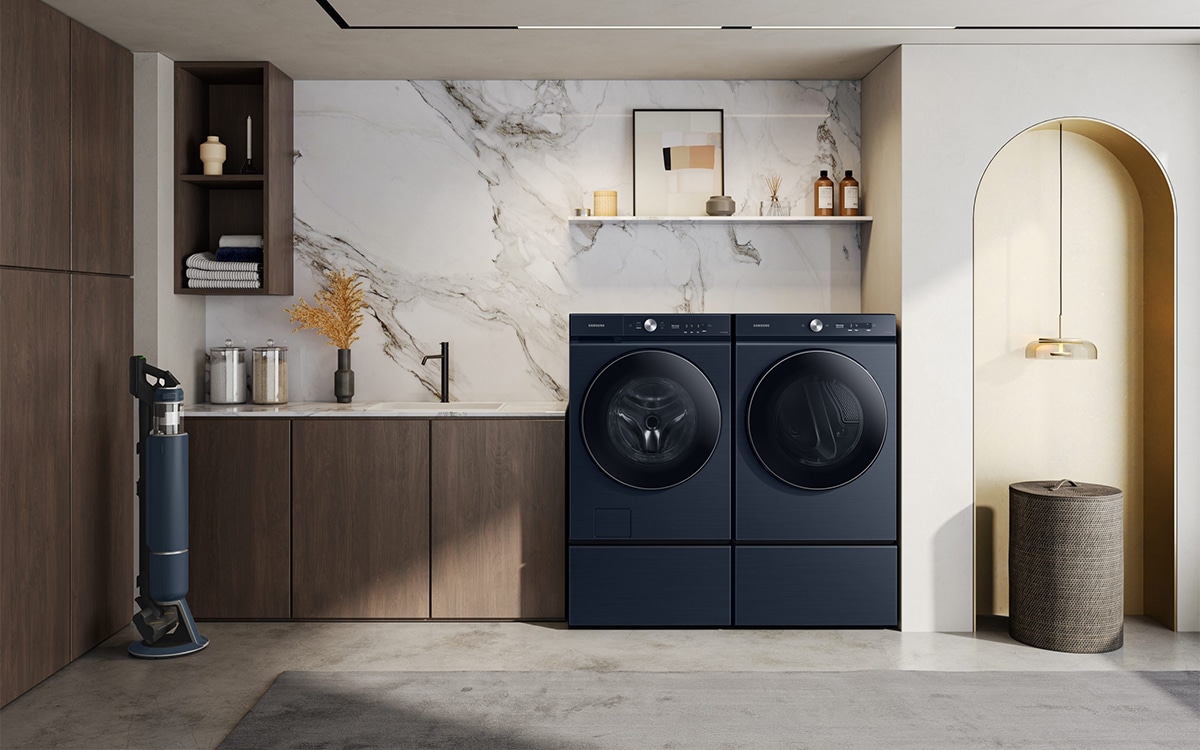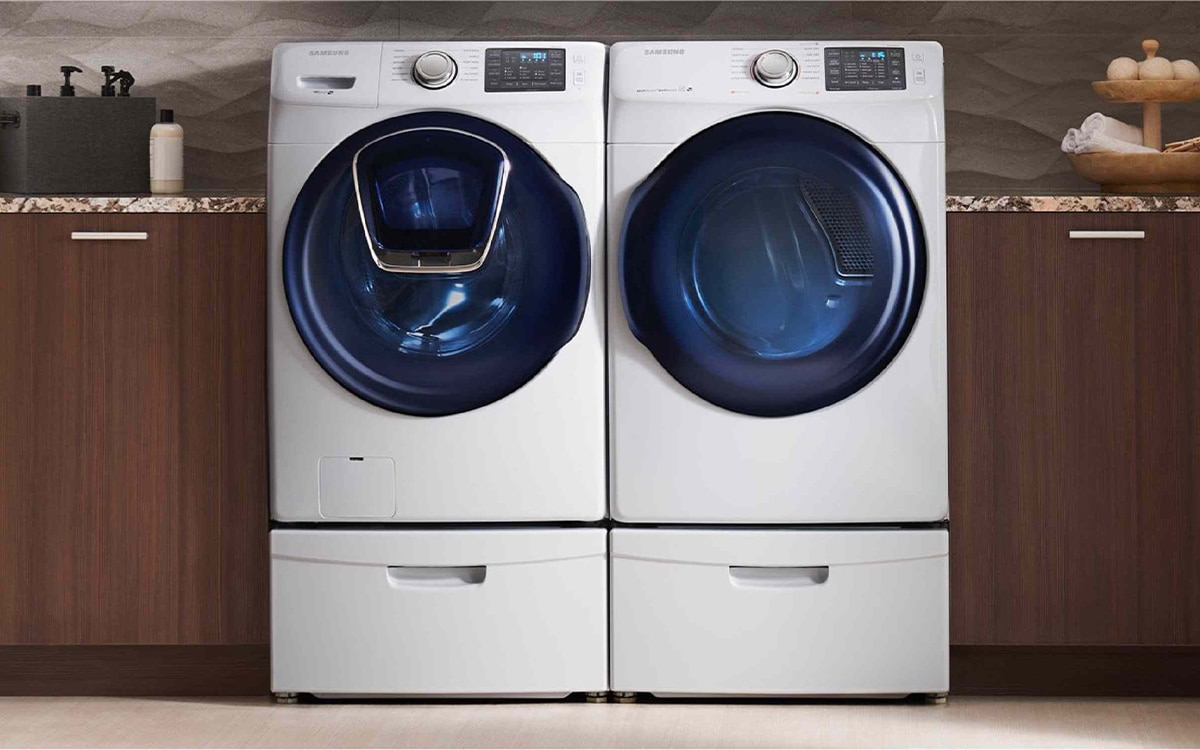But if you have limited space in your home, the idea of having both a washing machine and tumble dryer can seem totally unconscionable. Both appliances can take up a lot of space, and tumble dryers alone are notorious energy consumers. As such, many people turn to washer dryers to help them to save on space.
Washer dryers, as the name suggests, combine the glory of washing machines and tumble dryers into a single cohesive unit. With just one appliance, you can wash and dry your clothes in one go!
Are you on the fence about grabbing a washer dryer of your own? Or perhaps you already own one, and want to understand it better? Either way, our team of Reliant tech experts are here to answer all of your biggest questions in this definitive guide to washer dryers!
How Does A Washer Dryer Work?
In order to make the most of a washer dryer, it’s good to understand how exactly one works.
Washing
The washing cycle of a washer dryer operates almost identically to how it operates in a standard washing machine. First, water is drawn by the machine and then heated up to the exact temperature that you set the machine to operate at. Slowly, this water is added to the central drum, and spinning begins.
The rate at which the drum spins changes throughout the cycle, to achieve different effects. Towards the beginning of the cycle, the spin will be quite gentle, to beat dirt out of your clothes. Toward the end, the spin speeds up, in order to whip excess water out of your clothes.
At certain points in the washing cycle, any detergents you’ve dropped into the dispenser drawer are fed into the drum. These detergents are formulated to draw out and repel dirt from your clothes!
Drying
The drying cycle on a washer dryer operates very differently from a standard tumble dryer. Standard tumble dryers pump heat into the drum, and then condense all of the water from your clothes into a water tank. A washer dryer instead starts by warming up the central drum. This heat, combined with the spinning of the drum, slowly causes the water in your laundry to evaporate, and turn into steam.
Washer dryers operate very differently from standard tumble dryers. Instead of using a heat pump to dry your clothes, they instead heat up the drum and spin to whip water out of them.
This steam is then collected by a small vent at the top of the unit, before being sent onward to a condenser. The condenser is then responsible for turning the steam back into a liquid, collected at the back of the unit. This water is then drained through your plumbing system.
Do Washer Dryers Have Lint Filters?
Standard tumble dryers are equipped with handy lint filters that catch excess fibres that shed from your clothes. Unfortunately, in order to save on space, most washer dryers don’t have lint filters at all. Instead, pieces of lint are simply washed away with the water that drains at the end of the drying cycle. If pieces of lint are particularly big, they can run the risk of blocking your drainage pipes.
Is It Worth Buying A Washer Dryer?
At this point, you might wonder whether there’s any point in grabbing a washer dryer of your own. Or whether it would instead be better to simply grab separate devices. For the most part, we think washer dryers are a fantastic investment, especially for those with much smaller homes. Let’s take a look at some of the pros and cons of washer dryers, so you can decide whether to get one for your home.
Pros
They’re Incredibly Compact
You’ve likely grown tired of hearing it, but it really cannot be overstated how convenient washer dryers are for smaller households. An individual washing machine alone can take up a lot of floor space, and pairing it with a separate tumble dryer can result in even more vital floor space being taken up. Thus, combining the two appliances into one super-appliance can really help to bring some space back into your home.
Easier To Use
Because a washer dryer can perform both of the functions you need, you barely need to get involved in the process. If you were to use both a separate washing machine and tumble dryer, you’d need to move your soggy clothes into the dryer halfway through.
A washer dryer, on the other hand, can get started on the drying cycle as soon as the washing cycle has wrapped up! This saves you a lot of trouble, and allows you to focus on more important matters!
Can Be Used As A Washing Machine Or A Tumble Dryer
You can also use a washer dryer as if it were an independent washing machine or tumble dryer. Want to quickly wash your clothes but skip the drying cycle? You can do just that! Want to dry some clothes without having to wash them first? Just use a drying cycle alone.
Washer dryers are just as effective as their standalone counterparts. If you need to use the appliance as just a washing machine, or as just a tumble dryer, you totally can!
A washer dryer truly does give you the best of both worlds when it comes to these handy appliances.
They’re Good At The Job
You might assume that, because a washer dryer can do the tasks of two separate appliances, it might run the risk of spreading itself a bit thin. Luckily, our experience has shown that washer dryers are just as powerful and effective as their individual counterparts.
You won’t have to worry about sacrificing performance just for the sake of convenience. You’ll still get perfectly clean clothes that come out warm and dry after the cycle has finished!
Cons
No Lint Filter
Unfortunately, your average washer dryer won’t have any kind of lint filter built into it. This is unlike standard tumble dryers, which are equipped with full lint filters. These lint filters are designed to catch small fibres that fall off of clothes as a result of the drying process. Simply take the filter out every now and then, and remove the lint safely.
Washer dryers most often lack lint filters entirely. Instead, they often simply expel lint alongside water after the drying cycle has finished. A few models have pump filters that can effectively identify and withdraw lint from the machine. It’s worth looking out for these models.
They Can Take A Long Time To Do The Job
Unfortunately, if you’re planning on washing plenty of laundry, you might find it takes you a little longer with a washer dryer. Performing both a washing and drying cycle can take quite a significant amount of time. This means that if you need to wash multiple loads, it might take you much longer than if you were to run a separate washing machine and tumble dryer simultaneously.
If you often need to wash large laundry loads, we would recommend grabbing a washer dryer with a sufficient drum capacity.
Less Efficient Drying
Unfortunately, though the washing performance of a washer dryer is just as great as a standalone washing machine, the same cannot be said for the drying performance.
It can take a little longer to do your laundry with a washer dryer. Performing both cycles can take a while, so if you want to wash more clothes, it will take a few more hours!
In fact, some washer dryers actually end up using a lot of electricity and water just to perform a drying cycle. This means that a washer dryer could potentially cost you a little more to use.
The drying function on a washer dryer also requires that fewer clothes are inserted into the drum. While the washing cycle can handle a full laundry load, the drying cycle simply can’t handle quite as many clothes. To fully wash and dry all of your laundry, you may need to divide it into some smaller laundry loads and perform a few consecutive cycles.
How Much Electricity Does A Washer Dryer Use?
In the end, the amount of energy used by your washer dryer will depend on how often you’re using it, what settings you’re using, and whether you’re performing both a washing and drying cycle.
On average, a washing cycle tends to use around 1.5kWh. The drying cycle uses around 4.5kWh. As you can see, the drying function on a washer dryer is quite inefficient, and uses quite a lot of electricity. We’d recommend that the drying function isn’t used every time you do your laundry. Instead, save it for those times when you really need it.
If you need to dry your clothes every time you wash them, we’d recommend that you simply grab a separate washing machine and tumble dryer. The drying function on a washer dryer uses more energy and water than a standalone tumble dryer.

Should You Perform Regular Maintenance On A Washer Dryer?
We recommend that you perform regular maintenance on your washer dryer. Luckily, you won’t have to do it too often. Instead, we recommend a deep clean and maintenance check of your washer dryer at least once a year.
All you really need is a wet cloth, some soap, and a bit of elbow grease. Wipe down all of the main areas of the unit, such as the dispenser drawers, the drum, and the door. This helps to clear up any dried-up detergents and helps to free any trapped lint. This is especially important because when these elements are left on the inside surface of your washing machine, they can mess up your clothes! Lint and dried detergents can emit odours that then absorb into your clothes.
We recommend cleaning your washing machine at least once a year. Check for dried detergents and lint that might have gathered up in specific areas of the unit. This ensures full and efficient operation.
If your washer dryer has a lint trap of some form, we would recommend that you pull it out and clean it as often as you can. This keeps it working at its best, and also ensures that lint doesn’t get trapped elsewhere in the unit!
What Should You Consider In A Washer Dryer?
If you’re interested in grabbing your own washer dryer, we recommend taking a close look at some of the following factors.
Unit Size
Of course, the first thing you’re going to need to consider is the size of your new washer dryer. The reason why most people end up buying washer dryers is that they help to save on space. If this is the case for you, then you’ll want to make sure to choose a model that fits in your home!
Washer dryers can vary quite a lot in size, so there’s plenty to choose from. Make sure to choose one that offers you enough storage capacity, but that is also compact enough to fit in the home. You don’t want your washer dryer to be too big, as it will only take up space and get in the way.
Capacity
As we mentioned above, you need to get a washer dryer that is big enough for you
. Most often, a larger washer dryer unit comes with a much greater internal drum capacity. However, with that often comes a higher price tag.
You’ll need to strike a good balance between the size of your unit, and the capacity it offers. Be sure to consider how many clothes you need to wash. If you’re catering for a family, you’ll need a bigger unit! If you only need a washer dryer for one person, then you can go a little smaller.
Regardless, you want to make sure your washer dryer isn’t too big, and that it also isn’t too small. Making the most of your washer dryer’s capacity is key to efficient operation, and energy efficiency.
Energy Efficiency
We’ve explored already that washer dryers have a reputation as high energy consumers. While this might initially be off putting, there are some great ways to ensure your new one doesn’t use up too much energy.
The best way to find an energy-efficient washer dryer is to look for a solid energy rating. Energy ratings are assigned to different appliances based on how efficient they are. The more efficient they are, the better they will rank, on a scale from “A” to “G”. If you’re looking to really cut down on energy usage, we recommend you opt for a washer dryer as close to “A” as possible. Such a unit will cost you much less to operate and maintain.
It’s also best to go for a washer dryer that offers plenty of simple controls. Much of the energy used by a washer dryer is dedicated to generating heat. If you set the water to a high temperature or set the drying cycle going, the unit will consume more energy. A good washer dryer should allow you to easily choose a specific temperature, or choose to skip the drying cycle, to help you save energy!
Another feature that goes a long way towards improving energy efficiency is “Eco” mode. Many washer dryers come with handy eco-mode systems programmed to cut down on energy and water use. While the mode might operate under a different name, depending on your model, it’s totally worth using. Essentially, it lowers the temperature of the water, which in turn cuts down on energy use. It might take a little longer to do the job, but the money you’ll save is so worth it!
Noise Level
A washer dryer will inevitably create some amount of noise while in operation. However, some are definitely louder than others. Obviously, you’ll want your new washer dryer to be on the quieter end of the scale. Especially if you live in a much smaller home.
The noise level of a washer dryer usually tends to be around 60 dB on average. This is just above the noise level of an average indoor conversation. As such, we recommend that you place the unit in a separate kitchen or garage, away from social spaces like the living room or dining room. If you are truly limited in space, we recommend looking around for models with a volume level of around 50 dB or less.
Smart Connectivity
In the era of smart technology, it can be valuable to look out for appliances that can seamlessly connect to your smartphone. Smart appliances are able to connect to the internet and allow you to interact with various facets of their controls entirely remotely.
Smart connectivity allows you to control your washer dryer remotely, entirely through your smartphone. You can monitor cycles in real time, and even check on the health of the unit!
If you want your washer dryer to be easier to use, it can be worth looking for a model with smart connectivity. Controlling the appliance through your smartphone makes it much easier to choose specific cycle settings, to get exactly the experience you want. You can also monitor each cycle in progress, and also get unique insights into the unit itself. For instance, if there is an error with the unit, you’ll receive a notification on your phone!
Warranty
Naturally, you’re going to want your new washer dryer to be by your side for years and years to come. Luckily, the appliances are incredibly hardy and durable. However, we would suggest keeping your eye out for models with strong warranty periods.
A warranty will cover the cost of any repairs or replacements should any errors occur within the first few years you spend with the appliance. This helps to save you a lot of peace of mind, knowing that any damage will be covered for you.
A strong warranty can also give you a lot of confidence in the washer dryer you’re buying. You’ll be able to use the appliance with confidence from day one, knowing that it’s built to last!
Price
As you slowly narrow down your options, you’ll want to keep in mind how each of the factors we’ve discussed above can affect the total price of the unit. The larger the washer dryer is, and the more features it has, the more it is going to cost.
If a washer dryer has all of the functions you need, but costs a little more, then you might need to adjust your budget slightly. Either way, having some idea of your budget ahead of time is a great idea. It helps to keep you focused on your hunt for the perfect model and ensures you don’t spend too much or too little.
Make sure to grab a washer dryer with a fair price. You don’t want to spend too much on a model filled with useless features. Just like you don’t want to spend too little on an unsatisfying model!
After all, you don’t want to spend too little and end up with a useless washer dryer, just like you don’t want to pay too much for a washer dryer full of features that are of no use to you!

Should A Plumber Help You To Install A Washer Dryer?
Installing a washer dryer in your home is not the most complex procedure. But we still strongly recommend contacting a plumber to assist with the task. You can’t simply plug your new washer dryer into the mains and start using it. It also needs to be connected to your plumbing. A plumber can ensure that this is done fully and safely.
If you’re placing your washer dryer in a spot where there isn’t an existing plumbing connection, then you’ll most certainly need a plumber. They’ll be able to install pipes to ensure that the appliance can access and drain water.
Do You Need An Electrician To Help You Install A Washer Dryer?
For the most part, hooking up a washer dryer to power is not too difficult. All you need to do is plug it directly into a mains power supply. Thus, you shouldn’t need to contact an electrician to help install your new washer dryer.
However, if you’re putting your dishwasher somewhere without an existing plug socket, then you’ll need an electrician to help install one. You should also make sure that your washer dryer has its own circuit within the mains power supply. Appliances that consume a lot of electricity should never be hooked up to the same circuit as any other appliances. A separate circuit helps to prevent a power overload.
How Much Should You Fill Up Your Washer Dryer?
The answer to this actually differs depending on whether you plan to perform a drying cycle. Washer dryers are not quite as effective at drying as standard tumble dryers. As such, you need to make sure the drum is no more than half full for a drying cycle. You should plan your laundry tasks accordingly if you want to perform a washing and drying cycle. If you have to wash the clothes of your entire family, then we recommend that you have a washer dryer of a greater size.
If you’re just performing a washing cycle alone, then you should fill the drum to around 3 quarters full. Leaving a quarter of the drum empty ensures that there’s room for the clothes to move around. The more your clothes can move around, the more dirt and grime will be beaten out of them. Overfilling your drum will result in an unfinished clean, and could even damage the machine’s motor. The excess weight could cause the drum to spin off-centre!
However, you also want to make sure not to underfill your washer dryer. Not only would this be a significant waste of water and electricity, but it could also do harm to the unit. Again, underfilling the washer dryer could result in an uneven amount of weight being placed on the drum. This could cause it to spin off-centre.
You should fill your washer dryer no more than 3 quarters full if just washing. If just drying, it should be no more than half full. This ensures that the clothes can move around for a full clean.
It’s so important to choose a washer dryer with the perfect capacity. Otherwise, you run the risk of overfilling or underfilling the unit, as well as wasting water and electricity!
Why Does My Washer Dryer Not Dry My Clothes?
Unfortunately, if you don’t fill your washer dryer efficiently, you run the risk of your clothes coming out sopping wet even after a drying cycle. As we’ve explored previously, washer dryers are simply not as effective as standard tumble dryers when it comes to drying your laundry.
The drum of your washer dryer should be no more than half full before drying. This is because it allows for the steam from your clothes to more effectively escape. In turn, this results in a full and efficient dry.
If you overfill the drum before the drying cycle, it’s much harder for the steam to escape. This can result in your clothes coming out still feeling totally sodden!
Why Does My Washer Dryer Smell?
If your washer dryer has a strange smell, or your laundry is coming out with a slight odour, don’t panic. Most often, this is a result of residue being left in the unit after washing and drying. Pockets of dried detergent, lint, and dirt can gather up in specific spots of the unit. When left for too long, they might eventually create a strange and strong odour.
Make sure to wipe your washer dryer’s drum as often as you can. This helps to eliminate dried detergents, and pockets of lint and dirt that can become incredibly odorous.
This is why it’s recommended to clean the drum of your washer dryer every now and again. To help prevent these odours from building up.

Frequently Asked Questions
How Do Washer Dryers Work?
Washer dryers are able to perform the functions of both standalone washing machines and tumble dryers. This makes them incredibly convenient for smaller households. Everything is contained in one unit. They work similarly to ordinary washing machines, but include a special reservoir for collecting the steam that emits from clothes during the drying cycle.
What Are The Disadvantages Of A Washer Dryer?
One of the biggest drawbacks of washer dryers is that they are less effective at drying than standard tumble dryers. They use a different system for drying that is more compact, but less effective. In order to use the drying function effectively, you need to make sure the drum is no more than half full!
Does Washer Dryer Use A Lot Of Electricity?
Unfortunately, there’s no getting away from the fact that washer dryers consume a lot of electricity. When compared to other appliances, especially standalone washing machines and tumble dryers, they use a much higher percentage of energy per cycle. Luckily, the drying function is optional, so you can save money by only using it occasionally.







0 Comments